
Feature Articles
(I) Reconstitution and Handling of Powdered Infant Formula (PIF)
Breast milk is the safest food for babies, but due to work or some other reasons, many mothers feed their babies with PIF. To safeguard the health of babies, here are some tips on the reconstitution and handling of PIF for mothers and mothers-to-be.
Is PIF bacteria-free?
PIF is not a sterile product. In September 2008, the media reported Enterobacter sakazakii (also called Cronobacter species) detected in PIF. Enterobacter sakazakii, commonly found in our living environment, generally causes disease only in people with weakened immune systems. Although PIF contaminated by this bacteria can cause serious illness like blood or brain infections leading to serious complications and deaths, most infected cases concern only pre-term infants or infants with weakened immunity.
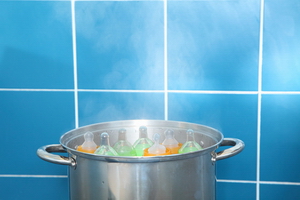
Reducing the risk of bacterial contamination in PIF
Reducing the risk of Enterobacter sakazakii contamination in PIF relies on effective implementation of preventive measures by manufacturers to minimise entry of microorganisms and avoid their multiplication, such as exclusion of water from the processing environment to the extent possible and feasible. In addition, it is also required to implement monitoring and environmental management programmes, which cover all relevant elements including the processing environment, product contact surfaces and finished product.
Here are some advice for parents to reduce the risk when reconstituting and handling PIF:
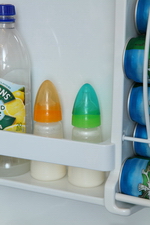
- Reconstitute PIF with water that is no less than 70oC (water left for no more than 30 minutes after boiling) and minimise the time from preparation to consumption.
- Feeds prepared in advance should be cooled immediately after preparation and stored in a refrigerator. Reconstituted feed should be used within 24 hours of preparation and re-warmed immediately before feeding.
- Re-warm reconstituted feed for no more than 15 minutes by placing in a container of warm water with occasional shake or swirl (the level of the water should be below the top of the bottle).
- Wherever possible, commercially sterile ready-to-feed liquid formula should be used for pre-term infants and infants with weakened immunity.
Advice to Manufacturers
- Implement preventive measures (such as Good Manufacturing Practice / Good Hygiene Practice and Hazard Analysis & Critical Control Point) as well as monitoring and environmental management programmes.
- Communicate the risk reduction measures that the caregiver should follow for the safe preparation, handling and use of powdered formula on product label.
In addition, the suitable water temperature for reconstituting PIF labelled or displayed on some electric pots is as low as 60oC. To reduce the risk of contamination by Enterobacter sakazakii and other microorganisms, it would be better if electric pot manufacturers could advise consumers to reconstitute PIF with boiled water that is no less than 70oC (say 75oC).
(II) Hygiene Guidelines on Handling Poultry Eggs
Sources of bacterial contaminations of eggs:
- bacteria can be introduced to eggs prior to shell formation if the hen is infected (e.g. with Salmonella);
- faecal contamination on egg shell when eggs are released via the cloaca (where excretion of faeces also takes place);
- contamination through environmental factors (such as farmers, pets and rodents).
Do not wash eggs
Improper washing may damage the cuticle on egg shells. Moreover, wetting the shell may facilitate the entry of microorganisms. Water left on shell surface may also enhance the survival of microorganisms on egg shells.
Many eggs sold on the market have actually been cleaned. The eggs are washed as soon as possible after they are laid, and those with cracks are removed. The surface of the eggs is sanitised with special detergents that do not damage the cuticle. Water used for washing is slightly warmer than the temperature of the eggs as water that is too hot will damage the cuticle, while cooler water will facilitate the entry of bacteria into the eggs. After washing, the eggs are dried immediately. In some cases, the eggs are sprayed with a layer of mineral oil to replace the original cuticle that may be lost during washing.
Advice to Trade
Store shell eggs under refrigeration.
Avoid cross-contamination between raw eggs and other food. The food contact surfaces and utensils used for preparation of raw eggs should be cleaned thoroughly.
Choose pasteurised egg products or dried egg powder to prepare dishes not requiring heat treatment, in particular ready-to-eat desserts.
Avoid using cracked eggs as they are more likely to be contaminated and thus present a higher health risk.
Wash hands thoroughly after handling raw eggs.

(III) Arsenic in Food
The name "arsenic" may not be as common as "pishuang" in Chinese. Pishuang is an inorganic arsenic compound. Arsenic is an element that is commonly found in nature. In brief, it exists in organic and inorganic forms. In nature, arsenic is often present in igneous and sedimentary rock as inorganic arsenic compounds. They may end up in soil, air, water or become airborne. The inorganic forms are more toxic to human, whereas the organic forms are of much less concern in toxicity.
How are people exposed to arsenic?
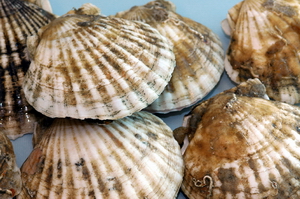
Generally, people are exposed to arsenic through drinking or eating. In areas where water is high in arsenic, drinking water is a significant contributor to the dietary intake. However, this is not of local concern. The level of arsenic in potable water in Hong Kong between October 2007 and September 2008 is well below the World Health Organization's provisional guideline value. Furthermore, absorption of arsenic through air and skin only plays a minor role in the general population.
How does arsenic end up in food?
As arsenic compounds are mostly soluble in water, arsenic is more likely to be present in seafood, especially shellfish, while arsenic present in fish is more often in the less toxic organic form. The use of arsenic-containing agricultural chemicals can lead to accumulation of arsenic in soil and plants, thus contributing to trace amount of arsenic in food. According to the Centre for Food Safety (CFS)'s Risk Assessment Study on the Dietary Exposure to Heavy Metals in Secondary School Students, their dietary exposure of inorganic arsenic per week is lower than the safety level.
What are the effects of arsenic on health?
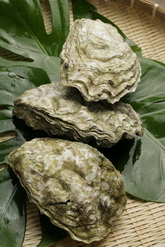
Even though " pishuang" may sound frightening to many Chinese, its toxicity is determined by the dose ingested. Acute poisoning due to arsenic present in food is rare. Symptoms of acute arsenic poisoning include severe vomiting and diarrhoea, accompanied by muscular cramps, facial oedema and cardiac dysfunction. Chronic exposure to inorganic arsenic via drinking water may cause peripheral vascular disease, and there is evidence showing that arsenic exposure may lead to cardiovascular diseases and hypertension. Arsenic and arsenic compounds are carcinogenic to humans, and arsenic in drinking water can cause cancer of the urinary bladder, lung and skin.
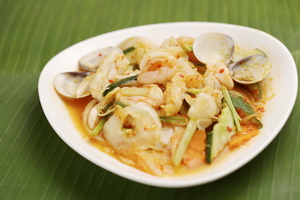
Advice to the Trade
Obtain food supplies from reliable sources and do not obtain shellfish and other seafood from contaminated areas.
(IV) The Oilfish Incident
A group of students was found suffering from oily diarrhoea and discomfort after consuming fish fillet in a restaurant in February 2009. The CFS collected the fish fillet samples for DNA tests to confirm the fish species. The restaurant surrendered the remaining frozen fish fillet for disposal. The CFS also traced the origin of food to prevent the reoccurrence of similar incidents.


This case reminds us of the oilfish incident in 2007 when complaints were received from members of the public who suffered from oily diarrhoea after consumption of fish products labelled as "codfish". After investigation by the CFS, the fish products in question were believed to be "oilfish" marketed as "codfish" or using names similar to "codfish". The symptoms were suspected to be caused by the presence of indigestible wax ester in the fish products concerned. In response to the incident, a Working Group was set up by the CFS, comprising representatives from Government departments, the trade, consumer group and academics, to advise the trade in the appropriate naming and labelling of "oilfish" and "codfish" and to draw up the "Guidelines on Identification and Labelling of Oilfish / Cod". According to the Guidelines, Ruvettus pretiosus and Lepidocybium flavobrunneum for sale should be labelled as "oilfish" in English. The import and sale of oilfish is permitted in Hong Kong. However, under the Public Health and Municipal Services Ordinance (Cap. 132), if any person sells to a purchaser any food which is not of the nature, or not of the substance, or not of the quality, of the food demanded by the purchaser, he shall be guilty of an offence.
Advice to the Trade
When buying fish and fish products, request the suppliers to provide a health certificate issued by the food / health authority of the exporting country. The health certificate should include the scientific names of the fish species. Check and verify the fish species with the suppliers.
Food caterers and food manufacturers should obtain fish and fish products from reliable sources. Avoid buying fish and fish products from improper channels.
Retailers and caterers should show the proper common names to consumers on food labels, signs and / or menus, and provide also the scientific names if practicable. For Ruvettus pretiosus and Lepidocybium flavobrunneum, the common name should be "oilfish".
The "Guidelines on Identification and Labelling of Oilfish / Cod" can be downloaded from the web page of the CFS: www.cfs.gov.hk.
Readers' Corner
(I) Lead Exposure in Our Everyday Life
Where does lead come from?
Lead is a metal often used in industry, such as in the production of petrol, batteries, paints and ceramic glazes. It is also used in soldering water distribution pipes and seaming food cans, and in making crystal glassware, etc. However, some of the above usages have already been or are in the process of being phased out due to advance in technology, and with the availability of unleaded petrol and unleaded paint.
How are people exposed to lead?
Breathing
As lead is an airborne contaminant, all people are exposed to a certain amount of lead through breathing. Smoking is another source of lead exposure.
Diet
For ordinary adults, diet is the main source of lead exposure. In places where lead pipes and fittings are still used, drinking water can be a source of exposure as lead may leach or dissolve from the plumbing system. However, as lead pipes and fittings are not used in the plumbing system in Hong Kong, drinking water is not a significant source of lead in the locality. Diet, air and dust are the main exposure sources for children. Young children frequently put their fingers and other objects into their mouths, and thus are more prone to ingestion of lead paint chips and house dust that may contain lead particles.
Everyday life
People in occupations such as painting and decorating, plumbing, construction work and car repair are exposed to higher levels of lead from their working environment.
In the past two to three decades, as a result of global efforts in implementing environmental control measures such as banning the use of leaded petrol and promoting better canning methods, there has been a general decline in total exposure to lead.
How does lead enter our food?
Lead presents in soil may be absorbed into plants (e.g. cereals and vegetables), and lead particles in air may accumulate on the surface of their leaves and stems. Aquatic food animals, especially shellfish, may accumulate lead from contaminated water and sediments. In addition, lead is sometimes added to food intentionally as an additive, an example of which is found in the preparation of lime-preserved eggs. Nevertheless, alternative food preservation methods are available in recent years to replace the use of lead. On the other hand, lead may be inadvertently transferred to food from lead-containing utensils such as food cans, ceramic ware and crystal glassware.
What are the health impacts of lead?
Short term exposure to high levels of lead can cause abdominal pain, vomiting and anaemia, whereas chronic low-level exposure can cause retarded cognitive and intellectual development in children. Infants, young children and foetus are more susceptible to the toxic effects of lead, especially in regard to the damages to their central nervous system. A study by the CFS showed that dietary exposure to lead among local secondary school students was well below the safety reference values, meaning that their dietary exposure to lead was unlikely to cause harmful effects.
Advice to the trade
- Observe Good Agricultural and Manufacturing Practice to minimise lead contamination in foods.
(II) Listeria monocytogenes in Food
Listeria monocytogenes is a pathogenic bacterium commonly found in the environment, particularly in soil, vegetation, animal feed, and in human and animal faeces. The bacterium can survive and multiply at temperature as low as 0°C, but can be easily destroyed under normal cooking temperature.
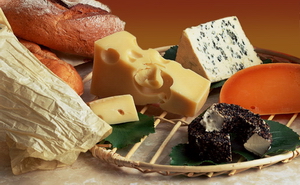
High risk foods
Listeria monocytogenes is widely dispersed in the environment and foods. Ready-to-eat (RTE) foods with long shelf life (such as soft cheese) and RTE poultry and meats (such as cooked cold chicken, cold-smoked fish and unacidified jellied pork tongue) are the most hazardous, as Listeria monocytogenes may grow at low temperature when given sufficient time.
High risk groups
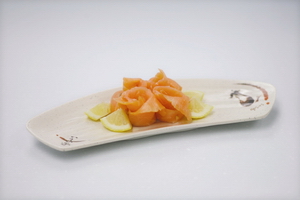
Foodborne listeriosis is a rare but serious disease with high fatality rate (20% - 30%). Listeria predominantly affects newborns, the elderly and immunocompromised individuals such as patients with AIDS, diabetes mellitus, cancer or kidney disease. Symptoms usually appear within 3 to 70 days (estimated median incubation period is 3 weeks) after consuming contaminated food. They range from flu-like symptoms, nausea, vomiting, abdominal cramps, diarrhoea, headache and constipation to persistent fever. Asymptomatic infection probably occurs in most people. However, serious infections of Listeria monocytogenes infection are manifested by septicaemia and meningitis.
Prevention of Listeria infection is of major concern in pregnant women. Even though symptoms may be relatively mild in mothers, the passage of Listeria monocytogenes through the placenta may cause miscarriage, stillbirth or perinatal septicaemia and meningitis in the newborns.
Advice to the trade
- Maintain good hygiene and food handling practices in food manufacturing plants, food premises and retail establishments.
- Avoid post-cooking contamination of RTE foods particularly those with long shelf life.
(III) What you should know about health food products
| Mrs CHAN: | "My dear, our neighbour Mrs WONG said that her daughter had outstanding examination results. Her daughter is also good at extra-curricular activities like playing the piano, swimming and dancing. I heard that she has been eating "smarter" health food products since she was a little girl. Perhaps we should buy some for our son to make him smarter." |
|---|---|
| Mr CHAN: | "My dear, if one can become smarter by eating such food product, there won't be any fools on earth, right? Don't believe in everything people say." |
| Mrs CHAN: | "I will attend a Talk on Nutrition and Health organised by the Centre for Food Safety tomorrow. I may ask the dietitian to confirm whether this is true. If so, we may buy some." |
| On the next day, during the Question and Answer session of the Talk…… | |
| Mrs CHAN: | "Dietitian, just now you said that in order to eat healthily, we have to pay attention to food hygiene and maintain a balanced diet. I heard that certain health food products in the market are beneficial for children's brain development and good for health. Are these health food products reliable?" |
| Dietitian: | "You should read carefully the labels on the health food products to fully understand what the ingredients are and their impact on the body. Besides, from 1 July 2010 onwards, nutrition labels will be available on pre-packaged health food products which do not contain any Chinese medicine or western medicine. The aims are to keep consumers better informed of the nutrient contents and to help choose healthy food. Of course, when purchasing health food products, we should make sure that they are within the expiry date. In fact, practising a healthy lifestyle is the key to good health. We should not rely on health food products. We can stay healthy by having a balanced diet, frequent exercise and a cheerful mood. We should also pay attention to personal, food and environmental hygiene and avoid smoking and alcohol. If dietary supplement is required, please consult professionals like doctors and dietitians as a safety measure." |
Food News
Turn and Look - For Healthier Food Choices
Nutrition Labelling Series - Energy
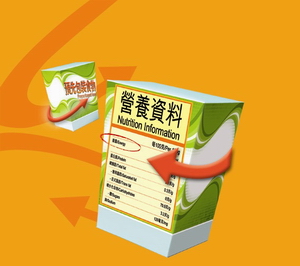
The Food and Drugs (Composition and Labelling) (Amendment: Requirements for Nutrition Labelling and Nutrition Claim) Regulation 2008 will come into effect in July 2010. In the coming issues, we shall introduce to you different aspects covered by the Regulation, including all the specified nutrients that are required to be labelled, nutrient content expressions, nutrition claims and the exempted items. In this issue, we would like to provide you with answers to some of the questions concerning energy.
Question 1: What is the relation between energy and nutrients?
After digestion and absorption, the energy in food will be released to give power for activities. Energy in food is mainly from carbohydrate, fat and protein. 1 gram of carbohydrate or protein provides 4 kilocalories (kcal) whereas 1 gram of fat provides 9 kcal.
Question 2: Is "kilocalorie", the unit for energy, the same as "calorie"?
Both "kilocalorie" and "calorie" are units for energy and 1 000 calories equal 1 kilocalorie. This is like the case for our commonly-used unit for weight where 1 000 grams in weight equal 1 kilogram. "Kilocalorie" (kcal) is the same as "Calorie" (Cal).
Question 3: What is the difference between "joule" and "calorie"?
Just as "gram", "tael" and "ounce" are all units for weight, both "joule" and "calorie" are units for energy. 1 calorie equals to approximately 4.2 joules. 1 000 joules equal 1 kilojoule (kJ).
1 000 grams = 1 kilogram
1 000 calories = 1 kilocalorie = 1kcal = 1 Cal
1 000 joules = 1 kilojoule = 1 kJ
Food Safety Plan Corner
Fried rice with ham and tomato sauce is a simple and tasteful dish. It is served in many restaurants. With a sweet-and-sour taste, it is loved by the people of Hong Kong. Although this is a simple dish, attention should be paid to some critical points on safety during its production. When preparing this delicious dish for customers, you may refer to the following production guidelines to ensure food safety.
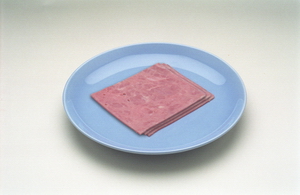
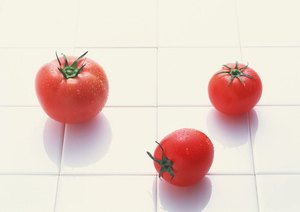
Ingredients
| White rice | 150 grams |
|---|---|
| Ham | 2 slices |
| Tomato | 1 piece |
| Mixed vegetables (corn, pea, carrot) | 30 grams |
Seasoning
| Tomato sauce | 2 tablespoons |
|---|---|
| Salt | 1 teaspoon |
Steps
- Rinse white rice. Cook white rice and let it get cool for later use.
- Rinse the ham, tomato and mixed vegetables. Shred the ham and cut the tomato into cubes.
- Preheat the wok and add 1 tablespoon oil. Add the ham, tomato and mixed vegetables. Then stir fry until they smell good. Add the rice and seasoning and stir fry evenly.
Production Process

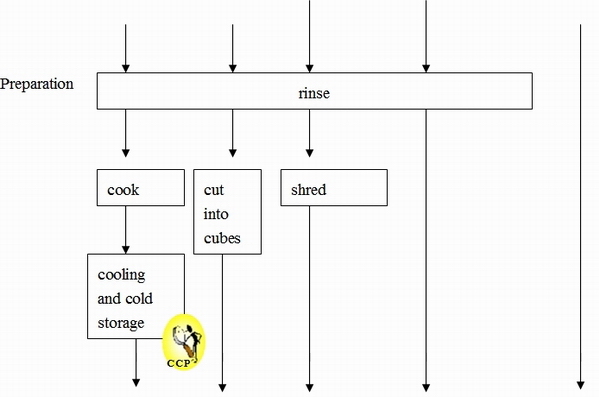
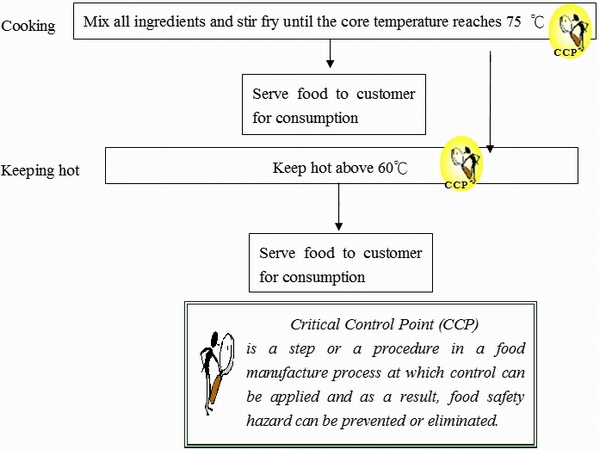
Guidelines on Production of Fried Rice with Ham and Tomato Sauce
- Purchase
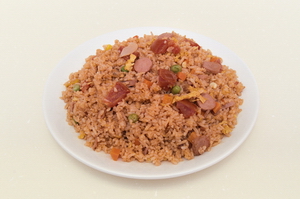
- Purchase the ingredients from reliable and hygienic suppliers.
- When buying and receiving the ingredients, make sure that
- the ingredients are fresh and wholesome.
- the tomato is not damaged and without bruised area.
- the ham and mixed vegetables are refrigerated at 4℃ or below.
- all the pre-packaged food items (e.g. tomato sauce, salt) are used before the expiry date.
- Storage
- Store the ingredients immediately at safe temperature.
- Refrigerate the ham and mixed vegetables at 4℃ or below. The temperature inside the refrigerator should be checked and recorded regularly with a thermometer to ensure that the fridge remains at 4℃ or below.
- * Practise the first-in-first-out principle for storage. Check and record the storage date of the ingredients.
- Store the ingredients immediately at safe temperature.
- Preparation
- Before cooking, wash all food contact surfaces (including worktops, chopping boards and utensils) thoroughly.
- Before cooking / in the course of preparing food, wash hands thoroughly with warm water and liquid soap.
- Use two different sets of utensils (including knives, chopping boards, bowls and chopsticks) to handle raw and cooked food separately.
- Before cooking, rinse the white rice, ham, tomato and mixed vegetables. Wash the tomato under running water and rub the skin.
- Cooling and chilling
- Cool the rice from 60℃ to 20℃ within 2 hours, and subsequently to 4℃ within 4 hours. (CCP)
- The cooled rice should be stored in a lidded container and refrigerated at 4℃ or below.
- After cooling,
- if the rice has been held at room temperature for less than 2 hours, it should be refrigerated or used before the 4-hour limit is up.
- if the rice has been held at room temperature for 2 to 4 hours, it should be used within the 4-hour limit but should not be returned to the refrigerator.
- if the rice has been held at room temperature for more than 4 hours, it should be discarded immediately.
- Adopt appropriate measures to ensure first-in-first-serve of rice which are cooked in advance, e.g. use date and time coding to show storage / display time of the rice.
- Cooking
- The food should be thoroughly cooked before consumption. Use a clean food thermometer to measure the core temperature of the food, which should reach at least 75℃. (CCP)
- Keeping hot / Consumption
- The cooked food should be served to customers for consumption as soon as possible. It should not be kept at room temperature for more than 2 hours.
- The food not for immediate consumption should be kept hot in a pre-heated plate or steamed pot above 60℃. (CCP)
- The remaining fried rice should be discarded and should not be served to customers for consumption after reheating.
- Management System
- A preventive food safety management system (such as the Hazard Analysis Critical Control Point) should be implemented to identify and control any food safety problems that may emerge during production.
Briefing of Activities
Sidelights of the Centre for Food Safety and World Health Organization
Joint Workshop on Total Diet Study
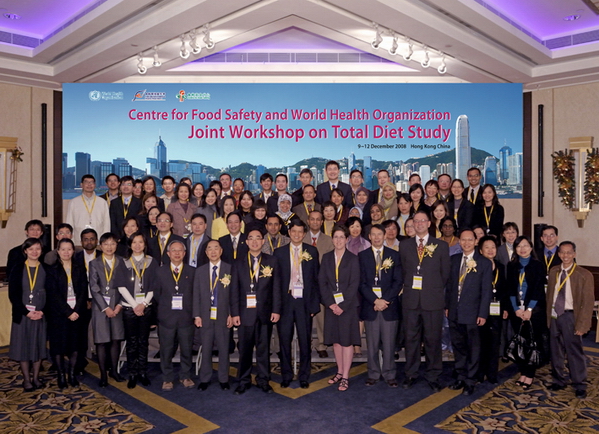
The Centre for Food Safety and World Health Organization (WHO) Joint Workshop on Total Diet Study (TDS) was held from 9 to 12 December 2008 at Hotel Nikko Hongkong, Tsimshatsui. This was the first event jointly organised by the CFS and the WHO.
TDS is recognised internationally as the most cost-effective way to estimate the average dietary intake of chemicals or nutrients for different population groups. It provides a scientific basis for risk management, which helps food safety authorities to focus their resources on chemicals and nutrients which have the highest public health risk. The four-day Workshop aimed to equip participants from different countries and regions with the knowledge and skills required for conducting TDS, and served as a platform for participants to share their experience and exchange views on the difficulties and challenges in implementing TDS.
The officiating guests of the Workshop were Dr Constance CHAN, Controller of the Centre for Food Safety, and Dr Seongsoo PARK, Scientist, Department of Food Safety, Zoonoses and Foodborne Diseases, World Health Organization. In addition to Dr PARK, the CFS was also very honoured to have the following distinguished speakers: Professor CHEN Junshi (Member, Chinese Academy of Engineering and Research Professor, National Institute for Nutrition and Food Safety, Chinese Center for Disease Control and Prevention, The People's Republic of China), Dr Gerald G MOY (former Global Environment Monitoring System / Food Manager, Department of Food Safety, Zoonoses and Foodborne Diseases, World Health Organization), Ms Julie BOORMAN (Senior Project Officer, the Scientific Strategy, International and Surveillance Section, Food Standards Australia New Zealand), and Dr Richard VANNOORT (Senior Scientist and Consultant Food Chemist, Food Safety Group, Institute of Environmental Science and Research Ltd, New Zealand). Other speakers of the Workshop included Dr HO Yuk-yin, Consultant (Community Medicine) (Risk Assessment and Communication), Centre for Food Safety, and Dr XIAO Ying, Food Safety Officer (Risk Assessment), Centre for Food Safety.
About 80 representatives from China, Bhutan, Chile, Indonesia, Malaysia, Nepal, Sri Lanka, Maldives, Vietnam, South Africa, Macau and Hong Kong attended the Workshop. Most participants were very satisfied with the arrangements for the Workshop, and said that in the four-day Workshop, they benefited greatly from the speakers' lucid presentation, pertinent exercise and warm discussions, and, during the experience-sharing sessions, learned a lot from the precious experience of various countries and regions in implementing TDS. These would be of immense help to them for conducting their own TDS.
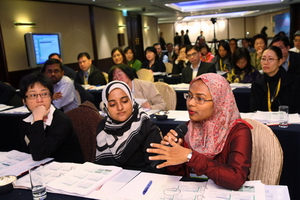
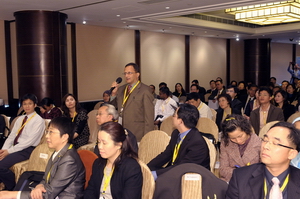
Nutrition Labelling (for the Trade)
The Food and Drugs (Composition and Labelling) (Amendment: Requirements for Nutrition Labelling and Nutrition Claim) Regulation 2008 was enacted by the Legislative Council last year and will come into effect on 1 July 2010. By then, most prepackaged foods will be required to be labelled with the content of energy and seven specific nutrients – protein, available carbohydrates, total fat, saturated fat, trans fat, sodium and sugars. The content of all claimed nutrients must also be provided on the nutrition labels. Furthermore, any nutrition claim made on food labels or in advertisements will be regulated. To assist the trade to better understand and comply with the Scheme, the CFS has specifically designed an interface within its website www.cfs.gov.hk for the Scheme, where useful information such as the "Technical Guidance Notes on Nutrition Labelling and Nutrition Claims", the "Method Guidance Notes on Nutrition Labelling and Nutrition Claims", Workshops on the Scheme, information on laboratories, frequently-asked-questions and their answers, etc., are uploaded. Members of the trade may call the Food and Environmental Hygiene Department's 24-hour Hotline 2868 0000 to listen to pre-recorded information on the Scheme and obtain relevant materials by fax, or call 2381 6096 to contact staff of the CFS for enquiry during office hours.